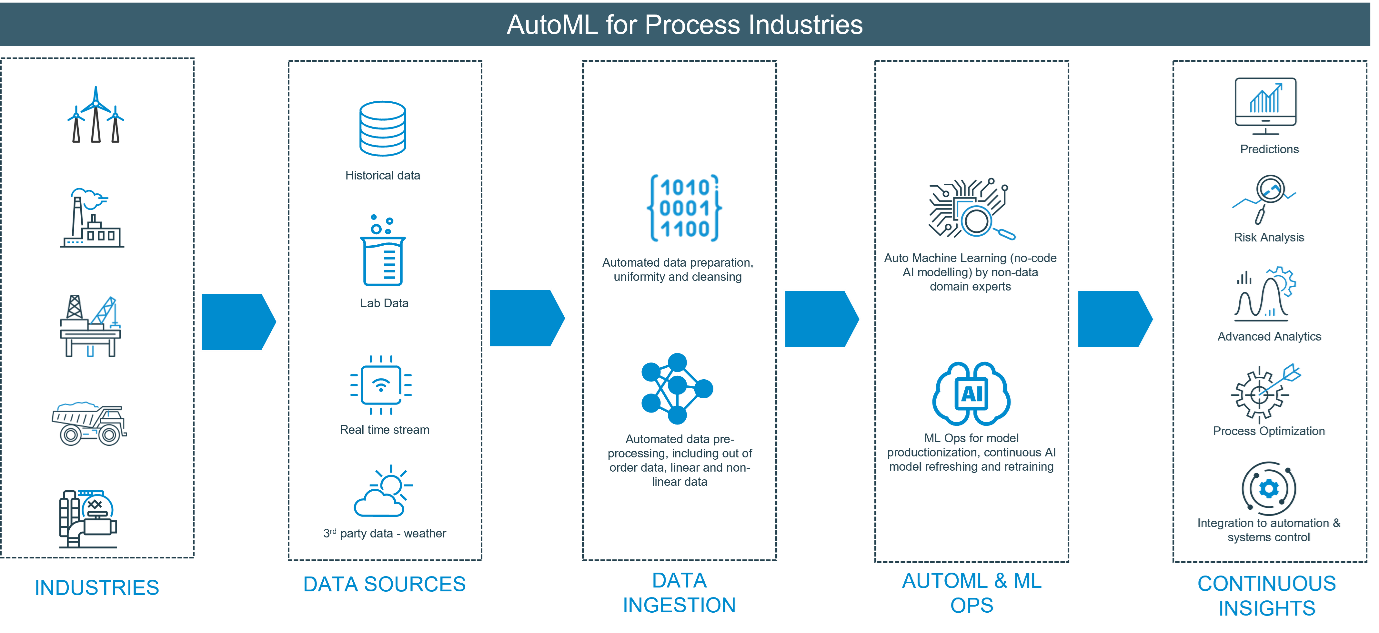Continuous processes can produce millions of data points in next to no time, a volume that makes it nearly impossible for operators to manually sort, analyze, and visualize. The tools which have been deployed to date, such as distributed control systems (DCS), programmable logic controllers (PLC), process historians, and supervisory control and data acquisition (SCADA) systems have allowed the industry to connect to their source data and use condition monitoring and remote operations, key aspects of industry 4.0.
However, what’s been lacking is the ability of these systems to learn from the available data to predict future outcomes. The prediction of future outcomes by machines is the next step in improving performance and automating many processes. The true benefit of producing time-based data and storing it is to be able to learn from it for a business advantage.
Automated machine learning (AutoML), a subset of artificial intelligence (AI), continuously learns from real-time and historical data, detecting patterns and trends to all operating conditions. With AutoML, it is possible for machines to detect connections between systems and processes that are considered to be separate, allowing them to understand root causes and corresponding factors for past asset failures, processing events, and incidents.
While machine learning is not new, traditional machine learning is typically used exclusively by data professionals and is a lengthy, manual process. AutoML automates the time-consuming, repetitive tasks of running thousands of models, testing algorithms and calculations, and producing model predictions using live operational data. With lots of data in the process industry, many of the requirement of AutoML can already be met, including:
- Historic data: AutoML learns from historic internet of things (IoT) sensor data, which includes both standard operation data as well as failure data. Typically, the more data available, the better. However, even with only a few months of data, AutoML can produce insights.
- Real-time data: Models cannot predict the future accurately unless they are deployed in the production environment with access to real-time data. MLOps or DevOps is the application of processes and tools for the effective deployment and model monitoring. End-to-end AI platforms often include both AutoML and MLOps features, allowing models to be automatically deployed into the live data environment, refreshing with new real-time data, and updating predictions.
- Holistic data: Unlike traditional business structures, which are siloed to focus on different operating spectrums, AutoML benefits from learning from data across the whole business. Holistic data can include all sensor data, all operational data, and even third-party data such as the weather, if that can have an impact on operations.
- Subject matter experts: Many AutoML platforms can be used by existing subject matter experts and engineering teams. These domain experts already understand the processes, can easily frame business problems and objectives, and have a handle on current operations. They are best suited to build the models and evaluate the results, rather than data professionals in different departments or external data science consultants.
With AutoML, continuous process industries can benefit immensely, uncovering valuable data insights including:
- Predictions: Process industries can use AutoML to predict a variety of scenarios, including when the next failure or undesirable event will occur, future values, equipment degradation for predictive maintenance (such as gearbox deviation on an oil and gas pump), and to identify root causes.
- Risk analysis: Risk analysis can be applied to AutoML models to provide operators with a better decision-making tool. This can also help prioritize workloads amongst teams and help senior management as they navigate competing corporate objectives and key performance indicators (KPIs).
- Process optimization: While the problems and objectives in every operation are different, if high quality data is available, AutoML models can be extremely useful in producing insights at a superior pace. Objectives range from increased yield, reduced power consumption or consumables, increased equipment utilization, comparison of systems, or decreased emissions. A power plant used AutoML to model the performance of two identical air supply units, identifying the root cause of reduced production, as well as excessive energy consumption and reliability issues.
- Automation and systems control: While subject matter experts and domain experience are critical to evaluating the insights produced by AutoML models and making business critical decisions, there are some automations that can be created to alleviate time consuming and routine tasks. AutoML platforms can be integrated with automation and systems control, and based on the predictions of normal operating conditions, certain automations may be permitted such as the configuration of settings. The integration of AutoML insights is the key to intelligent automation.
Automation is a must for continuous process industries that want to remain competitive. We have seen a more rapid adoption throughout the industry driven by recent global events, which have made remote operations and continuous monitoring imperative for many organizations. To automate further, businesses need reliable data insights as well as predictive insights, which can be produced using AutoML.





